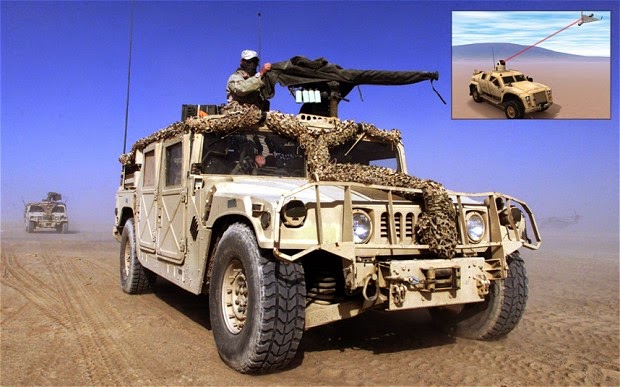As the Navy prepares to deploy its first laser weapon on a ship later this summer, Office of Naval Research (ONR) officials announced June 11 that they have finished awarding contracts to develop a similar weapon to be used on ground vehicles.
The Ground-Based Air Defense Directed Energy On-the-Move program, commonly referred to as GBAD, aims to provide an affordable alternative to traditional firepower to keep enemy unmanned aerial vehicles (UAVs) from tracking and targeting Marines on the ground.
ONR is working with Naval Surface Warfare Center Dahlgren Division and industry partners on the development of GBAD’s components and subsystems, including the laser itself, beam director, batteries, radar, advanced cooling, and communications and command and control.
“We’re confident we can bring together all of these pieces in a package that’s small enough to be carried on light tactical vehicles and powerful enough to counter these threats,” said Brig. Gen. Kevin Killea, vice chief of naval research and commanding general, the Marine Corps Warfighting Laboratory.
Some of the system’s components already have been used in tests to detect and track UAVs of all sizes. Later in the year, researchers will test the entire system against targets using a 10kW laser as a stepping stone to a 30kW laser.
The 30kW system is expected to be ready for field testing in 2016, when the program will begin more complex trials to ensure a seamless process from detection and tracking to firing, all from mobile tactical vehicles.
The US navy’s ship-mounted laser weapon which is due to deploy later this summer.
Unmanned VTOL Cargo Drone able to transport 3000 pounds will lead to drones able to transport people and carry cars
ARES is a vertical takeoff and landing (VTOL) flight module designed to operate as an unmanned platform capable of transporting a variety of payloads. The ARES VTOL flight module is designed to have its own power system, fuel, digital flight controls and remote command-and-control interfaces. Twin tilting ducted fans would provide efficient hovering and landing capabilities in a compact configuration, with rapid conversion to high-speed cruise flight.
It is envisioned that the flight module would travel between its home base and field operations to deliver and retrieve several different types of detachable mission modules, each designed for a specific purpose. Example modules could include:
* Cargo resupply
* Casualty evacuation (CASEVAC)
* Intelligence, surveillance and reconnaissance (ISR)
The ARES program would enable numerous benefits, including:
* Useful load capability as high as 3,000 pounds, more than 40 percent of the takeoff gross weight of the aircraft
* Flight performance similar to light aircraft
* Compact configuration and the ability to use landing zones half the size typically needed by helicopters of similar size
VTOL operations from prepared, unprepared and ship-based landing sites
* Unmanned operation, with a future path towards semi-autonomous flight systems and user interfaces for optionally manned/controlled flight
If you liked this article, please give it a quick review on ycombinator or StumbleUpon. Thanks

Brian Wang is a Futurist Thought Leader and a popular Science blogger with 1 million readers per month. His blog Nextbigfuture.com is ranked #1 Science News Blog. It covers many disruptive technology and trends including Space, Robotics, Artificial Intelligence, Medicine, Anti-aging Biotechnology, and Nanotechnology.
Known for identifying cutting edge technologies, he is currently a Co-Founder of a startup and fundraiser for high potential early-stage companies. He is the Head of Research for Allocations for deep technology investments and an Angel Investor at Space Angels.
A frequent speaker at corporations, he has been a TEDx speaker, a Singularity University speaker and guest at numerous interviews for radio and podcasts. He is open to public speaking and advising engagements.



